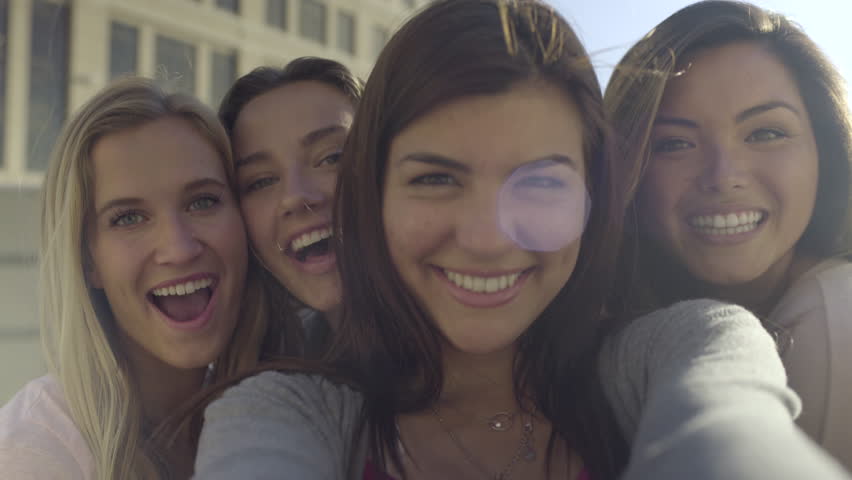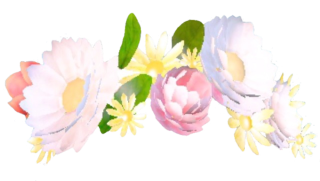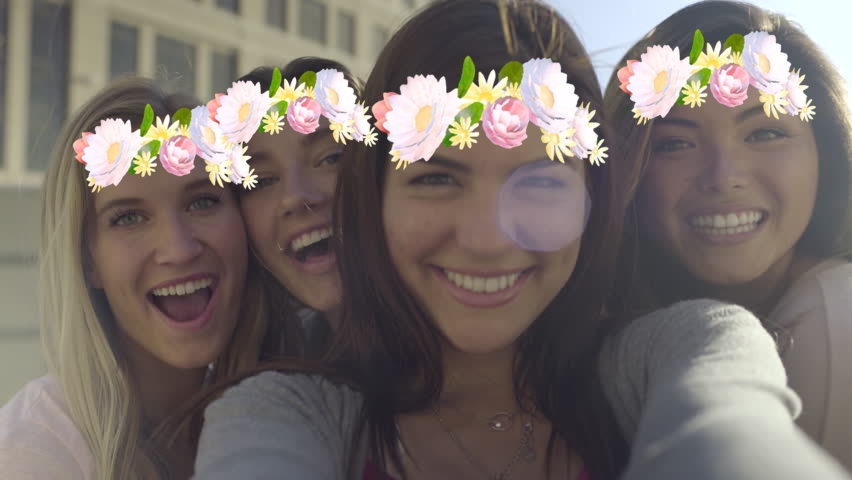Dada uma imagem de entrada com alguns rostos bonitos: 
e esta coroa de flor: 
localizada em pixlab.xyz/images/flower_crown.png
Produza algo assim:
Usando este código:
import requests
import json
# Detect all human faces & extract their facial landmarks via `facelandmarks`.
# Once done, mimic the famous Snapchat flower crown filter.
# Only three commands are actually needed in order to mimic the Snapchat filters:
# face landmarks: https://pixlab.io/#/cmd?id=facelandmarks
# smart resize: https://pixlab.io/#/cmd?id=smartresize
# merge: https://pixlab.io/#/cmd?id=merge
# Optionally: blur, grayscale, drawtext, oilpaint, etc. for cool background effects.
# The following is target image that we'll superpose our filter on top of it.
# This image must contain at least one face. free free to change the link to whatever your want.
# Note that you can upload your own images from your app very easily. Refer to the docs for additional info.
img = 'https://ak6.picdn.net/shutterstock/videos/10819841/thumb/8.jpg'
# The flower crown to be composited on top of the target face
flower_crown = 'http://pixlab.xyz/images/flower_crown.png'
# You PixLab API key
key = 'Your_PixLab_Key'
# This list contain all the coordinates of the regions where the flower crown should be
# Composited on top of the target face later using the `merge` command.
coordinates = []
# First off, call `facelandmarks` and extract all present faces plus their landmarks.
print ("Detecting and extracting facial landmarks..")
req = requests.get('https://api.pixlab.io/facelandmarks',params={
'img': img,
'key': key,
})
reply = req.json()
if reply['status'] != 200:
print (reply['error'])
exit();
total = len(reply['faces']) # Total detected faces
if total < 1:
# No faces were detected
print ("No faces were detected..exiting")
exit()
print(str(total)+" faces were detected")
# Iterate all over the detected faces and make our flower crown filter..
for face in reply['faces']:
cord = face['rectangle']
# Show the face coordinates
print ("Coordinates...")
print ('\twidth: ' + str(cord['width']) + ' height: ' + str(cord['height']) + ' x: ' + str(cord['left']) +' y: ' + str(cord['top']))
# Show landmarks:
print ("Landmarks...")
landmarks = face['landmarks']
print ("\tNose: X: " + str(landmarks['nose']['x'] ) + ", Y: "+str(landmarks['nose']['y']))
print ("\tBottom Lip: X: " + str(landmarks['bottom_lip']['x'])+ ", Y: "+str(landmarks['bottom_lip']['y']))
print ("\tTop Lip: X: " + str(landmarks['top_lip']['x']) + ", Y: "+str(landmarks['top_lip']['y']))
print ("\tChin: X: " + str(landmarks['chin']['x']) + ", Y: "+str(landmarks['chin']['y']))
print ("\tBone Center: X: " + str(landmarks['bone']['center']['x']) + ", Y: "+str(landmarks['bone']['center']['y']))
print ("\tBone Outer Left: X: " + str(landmarks['bone']['outer_left']['x']) + ", Y: "+str(landmarks['bone']['outer_left']['y']))
print ("\tBone Outer Right: X: "+ str(landmarks['bone']['outer_right']['x'])+ ", Y: "+str(landmarks['bone']['outer_right']['y']))
print ("\tEye Pupil Left: X: " + str(landmarks['eye']['pupil_left']['x']) + ", Y: "+str(landmarks['eye']['pupil_left']['y']))
print ("\tEye Pupil Right: X: " + str(landmarks['eye']['pupil_right']['x']) + ", Y: "+str(landmarks['eye']['pupil_right']['y']))
print ("\tEye Left Brown Inner: X: " + str(landmarks['eye']['left_brow_inner']['x']) + ", Y: "+str(landmarks['eye']['left_brow_inner']['y']))
print ("\tEye Right Brown Inner: X: " + str(landmarks['eye']['right_brow_inner']['x']) + ", Y: "+str(landmarks['eye']['right_brow_inner']['y']))
print ("\tEye Left Outer: X: " + str(landmarks['eye']['left_outer']['x']) + ", Y: "+str(landmarks['eye']['left_outer']['y']))
print ("\tEye Right Outer: X: " + str(landmarks['eye']['right_outer']['x']) + ", Y: "+str(landmarks['eye']['right_outer']['y']))
# More landmarks on the docs..Let's make our flower crown filter now
# Resize the flower crown which is quite big right now to exactly the face width using smart resize.
print ("Resizing the snap flower crown...")
req = requests.get('https://api.pixlab.io/smartresize',params={
'img':flower_crown,
'key':key,
'width': 20 + cord['width'], # Face width
'height':0 # Let Pixlab decide the best height for this picture
})
reply = req.json()
if reply['status'] != 200:
print (reply['error'])
exit()
else:
fit_crown = reply['link']
# Composite the flower crown at the bone center region
coordinates.append({
'img': fit_crown, # The resized crown flower
'x': landmarks['bone']['center']['x'],
'y': landmarks['bone']['center']['y'] - 10,
'center': True,
'center_y': True
})
# Finally, Perform the composite operation
print ("Composite operation...")
req = requests.post('https://api.pixlab.io/merge',
headers={'Content-Type':'application/json'},
data=json.dumps({
'src':img, # The target image.
'key':key,
'cord': coordinates # The coordinates list filled earlier with the resized images (i.e. The flower crown & the dog parts) and regions of interest
})
)
reply = req.json()
if reply['status'] != 200:
print (reply['error'])
else:
# Optionally call blur, oilpaint, grayscale, meme for cool background effects..
print ("Snap Filter Effect: "+ reply['link'])Os detalhes e as tecnologias por trás disso estão nesta postagem do blog .